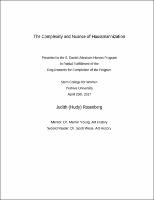Please use this identifier to cite or link to this item:
https://hdl.handle.net/20.500.12202/4113| Title: | The Complexity and Nuance of Haussmannization |
| Authors: | Rosenberg, Judith Hudy |
| Keywords: | Haussmann, Georges Eugène, baron, 1809-1891. Monet, Claude, 1840-1926. Caillebotte, Gustave, 1848-1894. Pissarro, Camille, 1830-1903. Seurat, Georges, 1859-1891. Renoir, Auguste, 1841-1919. Manet, Édouard, 1832-1883. City planning --France --Paris --History. Urban renewal --France --Paris --History. Architecture --France --Paris --19th century --History. Paris (France) --Buildings, structures, etc. Paris (France) --History --19th century. |
| Issue Date: | Apr-2017 |
| Publisher: | Stern College for Women |
| Abstract: | After his coup d’etat in 1851, Napoleon III took the throne on December 2nd, 1852. In 1853, he ordered his newly appointed prefect, Baron Georges-Eugene Haussmann, to modernize and reconstruct Paris. Baron Haussmann completely flattened and rebuilt Paris with wide boulevards and modern infrastructure. Thus, the subsequent modernization and transformation of Paris became known as Haussmannization. Haussmannization amounted to the complete transformation of Paris in the second half of the 19th century. Traditionally, art historians have taken a critical view of Haussmannization and have used their analysis of art to support their views. Art historian T. J. Clark combines artistic and historical analysis in his critique of Haussmannization. He comments on Haussmann’s transformation of Paris in terms of class and social structure. Clark is concerned with the changing, newly-consumerist society and he believes these negative changes are present and emphasized in Impressionist paintings. “[W]hat matters,” Clark writes, “is whether aesthetic orders have anything vital to tell us about bourgeois society.”1 He criticizes Haussmann’s modernization, saying “Here was ostentation, not luxury; frippery, not fashion; consumption, not trade.”2 Art historian Robert Herbert explains that Haussmannization helped turned Paris “into a society of strangers.”3 This statement seeks to convey the anonymity and diversity brought about by Haussmannization. |
| Description: | The file is restricted for YU community access only. |
| URI: | https://hdl.handle.net/20.500.12202/4113 https://ezproxy.yu.edu/login?url=https://repository.yu.edu/handle/20.500.12202/4113 |
| Appears in Collections: | S. Daniel Abraham Honors Student Theses |
Files in This Item:
| File | Description | Size | Format | |
|---|---|---|---|---|
| Judith-Rosenberg.pdf Restricted Access | 2.09 MB | Adobe PDF |  View/Open |
This item is licensed under a Creative Commons License

